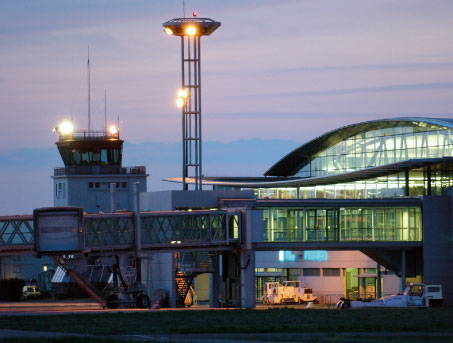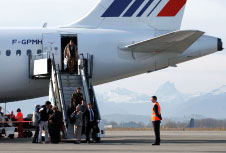
Cohen: “The quality of our services and our relationship with our passengers is our greatest asset in terms of creating an enhanced airport experience, and we are among the top airports in terms of customer satisfaction.” Photograph: Laurent Pascal
Located at the centre of the France’s Aquitaine region, Pau Pyrénées Airport is a key gateway for business travellers, pilgrim passengers and equine traffic. Now, as the airport enters a period of restructure across its air travel network, it is exploring opportunities for new routes from across the continent. Rising charter traffic, a vast increase in freight operations and a continuing influx of business passengers has provided Pau Pyrénées Airport with a wealth of possibilities to enhance its route network with flights from all over Europe.
Air France is Pau Pyrénées Airport’s biggest carrier, and since Ryanair ceased operations in 2011, no low-cost carriers currently serve the airport. Now, the airport’s development strategy is one with a definitive focus: to amplify its passenger traffic by acquiring new services from a more diverse range of carriers and reinitiating a programme of low-cost services.
“As well as expanding our network in France with different new routes – Strasbourg, Lille and Nantes – the airport wants to have an alternative to Air France, which is currently particularly present in Pau,” said Airport Manager Jean-Luc Cohen. “Our aim is to develop new routes to complement our current business destinations – Paris, Lyon and Marseille – and expand our leisure activities all over Europe by building connections with cities such as Madrid, Rome, Dublin, Amsterdam and Brussels.”

The airport, which serves as a major gateway for business passengers, aims to enhance its European route network in the coming months with the introduction of new services from a diverse range of airlines, including LCCs.
In 2012 the airport handled around 610,000 passengers, -5% fewer than in the previous year. This year, Cohen explained, it is predicted that throughput will make a rapid recovery, with numbers forecasted to rise to 625,000. The increase will come as a result of newly introduced low-fare flights from Air France – ‘Mini’ fares to Paris Orly and London City airports and the HOP! service to Lyon – which are expected to appeal to a wider passenger sector and enhance the airport’s traffic by +5-10%. A new seasonal service to Bastia, Corsica, will also run between May and October with HOP!. In the near future the airport also hopes to secure low-cost services to Belgium, Italy, Spain and the UK, which, if realised, will serve to further boost passenger traffic.
Burgeoning freight operations are also anticipated at Pau Pyrénées in the coming months. The airport serves as an important channel for the worldwide transport of horses, importing cargo from Europe and exporting to destinations across the globe. The Pau Béarn Chamber of Commerce and Industry is currently composing an application for approval of its status as an equine Border Inspection Post. Set in the third-largest economic region in southwest France, Pau Pyrénées Airport is also a major gateway for a multitude of major international corporations dealing in geosciences, aeronautics and mechanics. Cohen explained that the airport is also focused on developing its business aviation division for 2013, and, in addition, will continue to attract increasing custom from pilgrim passengers making the voyage to nearby Lourdes from the US, Asia, South America, and Africa.
Inside the terminal, the airport’s focus remains on delivering an exceptional passenger experience. “Taking into account the size of our airport, the quality of our services and our relationship with our passengers is our greatest asset in terms of creating an enhanced airport experience, and we are among the top airports in terms of customer satisfaction,” Cohen commented. “On trends in assistance, we are embracing the most advanced technologies in self-service check-in and bag drop,” he concluded.







